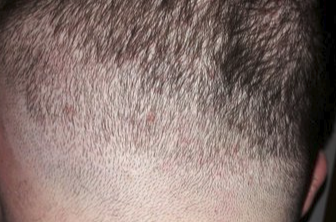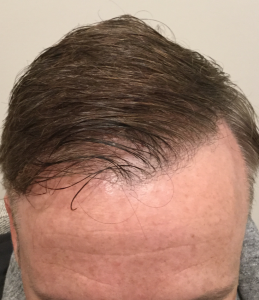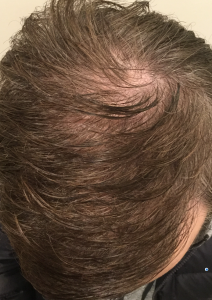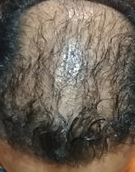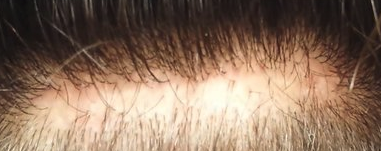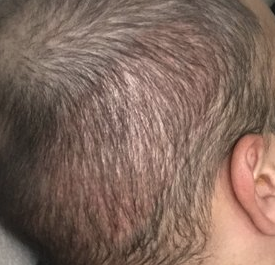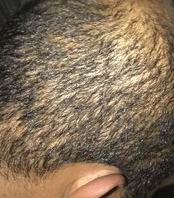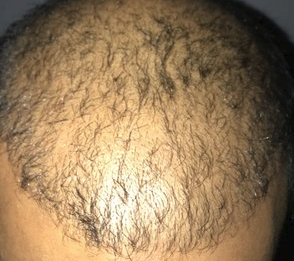I can now see through to the scalp in the back of my head, which looks like it is balding now. Will the hair grow back in the donor area?
After an FUE, the hair that was removed is gone forever and will never regrow. In African hair, the donor supply is numerically lower than both Asians and Caucasians by as much as 10% to 40% respectively. As a result, the limits for FUE are much more restricted in people of African decent. If you are a typical African American, then the limit for FUE should have been 1,400 grafts (see this link which explains this: https://newhair.com/donor-area/). You have what we call donor site depletion. Since you now have donor area depletion, the only thing that you can do, which works very effectively, is Scalp MicroPigmentation (see here: https://scalpmicropigmentation.com/scar-covering/).
You used the term 7,200 hairs, not 7,200 grafts. The average Caucasian has about 8,500 hairs in about 4,500 grafts. I don’t know why the doctor used the term hairs instead of grafts, other than to make you think you got more value. There is a standard nomenclature that is used in this industry, and doctors who go outside of this standard nomenclature often do so to mislead the patient.
Some people develop a pink color due to their skin type, if they have histamine positive skin. I usually find out ahead of time by having the patient use their fingernail to scratch their forehead. If it turns pink in the first few minutes, I tell the patient that he or she will have a pink wound after the surgery, as you seem to show. If you are worried about having an infection, go back and see your doctor. However, if this is just a histamine response, it will resolve in time (sometimes it takes weeks or in a few patients, a few months). Going back to your doctor is your best bet.
Residual hair remaining from transplanted grafts is not uncommon. It is best to leave them alone, and they will eventually shed in a shower or when the new hair grows in.
These pictures are of a 50 year old male who is holding on to his hair by using finasteride and minoxidil for 15+ years. The crown and the front hairs are all miniaturized so despite the extensive miniaturization, as long as he continues to use these medications, he will retain his look, possibly into his 60s and 70s.
There are sexual side effects in 2-4% of men who take Finasteride. Over 99% of these men who stop the drug find that the sexual side effects go away. Possibly less than 1% find some persistent sexual side effects.
The reason why so many men afraid of finasteride from tressless
There are many types of trichophytic closures, and I don’t know which type you had done. Many just don’t work well. The ones that do work well create a 4 mm shelf on the lower edge of the wound, and this area is buried below the skin. So, when the hair grows, it grows through the scar to the 4mm distance. You can have a scar revision with a properly done trychophytic closure, or you can have scalp micropigmentation which will effectively hide the scar.
Below is an example of a properly done Trichophytic closure (right of your photo).
The more FUE grafts that are taken from the donor area, the more see-through the donor area is. This is what happens when more doctors and people push the FUE to greater and greater numbers; more balding appears in the donor area. Your history of 4,400 grafts suggests that your donor density was low, which would create this problem.
Hair transplants work very well when you are balding. I had hair transplants for my crown, and no one knows unless I told them. I performed hair transplants on 6 relatives, including my wife and daughter-in-law, and they were all happy with them. There is a balance between your concerns about balding and your sense of need to do something about it. Hair transplants are not for everyone. Even though I invented the FUE, I still perform half of our hair transplants with strip surgery, often in older men or men who are going to develop an advanced balding pattern. The decision to do an FUE vs FUT is a personal decision for each patient.
I would need to know how many grafts you had done. The donor area would need to be evaluated. You might not be a candidate for another FUE if you had the usual 4,000-5,000 FUE grafts done in Turkey, but a strip surgery might make sense if your donor area is depleted. Without an evaluation of your donor area, it is impossible to judge what can be done. FUE has its limits and the question is: have you pushed FUE limits?
https://www.medicalnewstoday.com/articles/319848.php
This article seems to cover it all and is worth reading.
https://www.medicalnewstoday.com/articles/319862.php
This is a good review on the different approaches to getting a thicker head of hair. I am not necessarily endorsing this article, and certainly not all of the recommendations are valuable.
A male who is 22 should not have a hair transplant or hair line advancement surgery because if you do and you develop balding behind the corrected hairline, you will not look normal. If you undergo hairline advancement surgery, you will see a scar if recession occurs. If you have a hair transplant before your balding pattern become evident, then you will be chasing hair transplants for the next decade. You should wait until your potential balding pattern becomes evident, which is approximately 25 years of age. Build a Master Plan for your hair loss with a good doctor.
To answer your basic question, assuming you are at least 25, if your balding pattern is not going be be advanced, then you can have any hairline you want, even one better than a few years ago.
is it possible to get hair transplant for naturally receded hairline? from tressless

